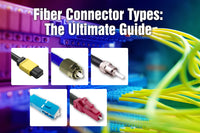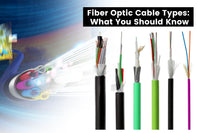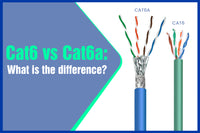Contents
Optical fiber communication technology has become an important bridge to build the modern communication network. And fiber optics has been more and more important in people’s daily life.
More and more households subscribe to fiber Internet and fiber patch cords have been widely used in FTTH and other data communications. But many people may be perplexed about various fiber optic patch cables due to different characteristics. This article will talk about all things about fiber optic patch cables and hope it can help you choose the right fiber patch cord.
What is Fiber Patch Cord?
A Fiber patch cord, also named as a fiber patch cable or fiber jumper, is a fiber optic cable that is terminated with different types of fiber connectors. These fiber connectors allow the fiber patch cord to be quickly connected to an optical switch or other telecommunication devices. Fiber patch cable plays an important role in indoor fiber use such as in data centers, server rooms, or other LAN applications.
How to Choose Fiber Patch Cord for Your Network?
There are different types of fiber patch cords on the market and do you know how to choose the correct fiber patch cord for your network? We’ll give you a step-by-step guide.
Before anything else, you should be clear about your requirements. Fiber patch cords can provide large bandwidth at a high speed, which is suitable for different applications. Do you want to use a fiber patch cord in FTTH (Fiber to The Home), communication rooms, LAN (Local Area Network), FOS (Fiber Optic Sensor), or other applications? Just make sure the fiber patch cord application.

When you have already identified your needs, the next step is to choose the type of fiber patch cable. There are various fiber patch cords and here are some factors that you should consider when selecting the fiber jumper for your network.
Fiber Patch Cord Types
Single Mode or Multimode Fiber Patch Cord
- Single mode fiber patch cable: Single mode fiber patch cable only supports one mode of a light signal. It is usually used to transfer high-speed data with low attenuation over a long distance. Single mode fiber can often be divided into two types: OS1 and OS2.
- Multimode fiber patch cable: Multimode fiber patch cable allows multiple modes of light to travel through the fiber core and it is more suitable for short-distance transmission within the building or office. Multimode fiber patch cables can be classified into OM1, OM2, OM3, OM4, and OM5. You can choose the correct one according to your need.
The biggest difference between single mode and multimode fiber patch cords is the core diameter. Single mode fiber patch cord features a core of about 9 microns and multimode fiber patch cord has a core of 50 microns or 62.5 microns. The fiber core of OM1 is 62.5 microns and that of OM2, OM3, OM4, and OM5 is 50 microns, which can be distinguished by the jacket color. Learn more from Single Mode vs. Multimode Fiber.

Simplex or Duplex Patch Cord
- Simplex patch cord: A simplex patch cord only has a single fiber cable and one fiber connector at each end. It only allows the data to transmit in one direction and that’s not reversible. Simplex patch cords are generally used within the building, suitable for Ethernet switches or other devices.
- Duplex patch cord: A duplex patch cord features two strands of fiber optic cable and two fiber connectors on each end to send and receive data. Duplex patch cords are often used to connect high-speed network devices such as server systems and fiber optic switches.

Fiber Connector Types
There are various fiber connectors on the market including FC, ST, SC, LC, MT-RJ, MPO, CS connectors, and so on. Among these fiber connectors, SC, LC, ST, FC, and MPO connectors are the most common.
- ST Connector: ST connector (Straight Tip)also features a 2.5mm ferrule. It is easy to install thanks to its spring-loaded design. ST connector is suitable for both single mode and multimode fiber optic cables. It is widely used in short or long-distance applications and it is also commonly used in industrial and military applications.
- SC Connector: SC stands for a square connector or subscriber connector that has a 2.5mm ferrule. It is commonly used for its low cost and easy installation. SC is widely used in PON (passive optical networks) and converters.
- LC Connector: LC means lucent connector or little connector. It features a smaller ferrule than SC, which is very suitable for high-density installation in FTTX and panels.
- FC Connector: Ferrule connector was the first fiber optic connector that features a ceramic ferrule. It is highly recommended for an environment full of vibration because of its screw-on design. But FC has been gradually replaced by other fiber connectors such as SC and LC.
- MPO/MTP Connector: MPO/MTP connectors are very popular nowadays. It features the function of multi-fiber connectivity and is widely used in high-density network cabling with 12 to 24 fibers.

FOR MORE INFORMATION, SEE Fiber Connector Types.
Fiber patch cords can have either the same or different fiber connectors on two ends. For example, there are LC to LC fiber patch cables, SC to SC fiber patch cables as well as LC to FC cables. Whether to use the fiber patch cord with two different fiber connectors or the same connector depends on the device that you’re using. For example, if the ports of the equipment are the same, you need to choose the fiber patch cord with the same connector.
Fiber Patch Cable Polish Types
It's known that when the fiber end is connected to the fiber connector, it may cause some data loss. It will lead to Optical Return Loss (ORL), which means that some light signals will be reflected back to the fiber. To minimize the back reflection, fiber optic connectors are usually polished to different types. The three most common polish types are Physical Contact (PC), UPC (Ultra Physical Contact), and APC (Angle Physical Contact).

Whether you choose PC, UPC, or APC depends on your own needs. Compared to PC, UPC and APC provide less return loss and better signal. Typically, the PC has a return loss of -40dB, the UPC is around -50dB and the APC is about -60dB. Compared to UPC, APC is more suitable for long-distance applications such as FTTx and Passive Optical Networks (PON).
Jacket Types
There are different fiber patch cord jackets including PVC, LSZH, OFNP, and others. Fiber patch cable covered with PVC jacket is widely used in the cabling system. LSZH fiber patch cable is more rigid as it contains flame-retardant materials. This type of fiber patch cable offers low smoke and toxicity. OFNP fiber patch cable is the highest degree of fire-resistant cable. PVC fiber patch cable is recommended for indoor use; LSZH cable is more suitable for public applications, and OFNP cable is used to install in pipes and plenums.
Finally, you should choose the suitable length of the fiber patch cord according to the distance between the two devices. Remember, if the fiber patch jumper is too short, it can be difficult to connect, and if it is too long, it can be easy to damage.
A Small Tip: Since the fiber jumper is a bit fragile, you’d better use the fiber strain relief boot to protect the fiber connector. Protect the optical fiber from dust and oil as they will damage the fiber. Suppose the optical fiber connector is unfortunately dirty. In that case, you can use an alcoholic cotton swab to clean it or use a professional dust collector for cleaning.
Fiber Pigtail vs Fiber Patch Cord
You have already known that a fiber patch cord is a fiber optic cable terminated with two fiber connectors on each end. But do you know what a fiber pigtail looks like? In fact, a fiber pigtail features a fiber optic connector on one end and an unterminated optic fiber cable on the other end. A fiber pigtail can be thinner than a fiber patch cord. Sometimes, a fiber patch cord can be cut to make two fiber pigtails.

Fiber patch cords and fiber pigtails share some similarities, but they may also be used in different applications. The fiber pigtail is generally used in Optical Distribution Frames (ODF) and fiber terminal boxes. In addition, fiber pigtail supports fusion splice termination in the fielding.
Final Thoughts
With the development of the network, fiber optic patch cords have been more and more popular. FTTH fiber optic patch cords have been widely used nowadays for a faster and more stable network. FTTH drop patch cords can be used outdoors and indoors with slightly different designs, and you can choose one according to your own needs.

For more information on this topic, you can keep up on our blogs. While VCELINK offers general and basic information for our customers and other visitors to the website, it’s not professional advice.




Be the first one to comment.
Leave a comment